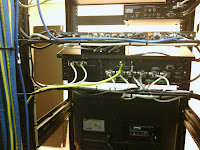This isn't a comprehensive list, but a few stories and trends that, for whatever reason caught my attention.
Extron left Infocomm, Finally released XTP
I was at Extron for one of their week-long training classes the week that this news broke, and it took everyone by some level of surprise. Not too many years ago, if I were designing a high-end conference room I'd start with an Extron switcher without a second thought. They didn't seem to follow the shift to digital as quickly as many of their competitors, and today I'd still choose Crestron Digital Media or AMX Enova before Extron's newer XTP. They have some nice ideas and features, but I'm not sure if they're quite there yet. Still, Extron had an interesting year, debuting several intriguing new products including the first energy-star certified amplifiers, audio DSPs, and signal extenders with varying price-points and specifications.
 They also opened an impressive showcase in their Saloon and Ranch, using their own control products along with some nice Meyer Sound line arrays. It's loud and sounds amazing. Here's hoping that 2013 is a good year for them, whether or not they come back to the big trade shows.
They also opened an impressive showcase in their Saloon and Ranch, using their own control products along with some nice Meyer Sound line arrays. It's loud and sounds amazing. Here's hoping that 2013 is a good year for them, whether or not they come back to the big trade shows.Avaya buys Radvision. Polycom moves to software
Since Cisco purchased Norwegian teleconferencing giant Tandberg they've been the force to recon with in the telecommunications/telepresence/unified communications arena. Logitech purchased Lifesize, leaving not too many independent operators in the telepresence field. Avaya threw their hat into the teleconferencing ring by purchasing Radvision. Radvision has both teleconferencing appliances (including integrated 4 and 8port MCUs on even the smaller ones) and a suite of software-based desktop applications.
Polycom, meanwhile, seems to be taking steps to move away from appliance-based solutions and towards software. The name of their RealPresence CloudAxis might sound like it came from a buzzword bingo card, but the idea of a secure, enterprise quality video system which can link Skype, standards-based VTC appliances, GoogleChat, Microsoft Lync, and even Facebook is a very good one. I'll be interested to see where this goes.
Green AV is something we talk about. But that's about it.
There are steps towards more sustainability in the AV field, from RoHS-compliant hardware to the first Energy Star certified AV product (the aforementioned Extron's XPA line of amplifiers), but it's still nowhere near the top of anybody's list. This is a conversation I'll be looking to continue next year, with Gina Sansivero of Project Green AV and others. Until there are LEED or other certifications available for green AV it will likely not be anyone's top priority, but it's still worth thinking about.
I left AV Project Management for Project Engineering
 |
| My workspace at Biamp Training |
I left AV Project Engineering for Consulting
It's been a whirlwind. Late summer I left AVI-SPL and took a step even farther from the hands-on part of the industry towards the pure design realm of consulting with the firm of SM&W. I've already had the chance to work on some eye-poppingly cool projects, met some more very talented colleagues, and am genuinely enjoying this next phase of my professional life. In addition to the other skills acquired over the past year, I've learned the basics of Revit, much more abotu AutoCAD, and even took part in my first screening-room design. This is a role where my borderline-obsessiveness (the first thing I notice anywhere I go is AV) really fits in and will pay off.
Those are my personal thoughts at the close of 2012. In 2013 I look forward to learning more, seeing more, doing more. I've also made a New Years resolution to update this blog at least weekly, so watch this space.










